Effect of Graphite Content on Mechanical Properties and High-Temperature Tribological Behavior of Cu-Ni-Sn-Mo-Gr Self-Lubricating Composites
Abstract
1. Introduction
2. Materials and Methods
2.1. Material Preparation
2.2. Material Characterization
2.3. Friction and Wear Tests
3. Results
3.1. Material Features
3.2. Tribological Properties
3.3. Worn Surfaces and Wear Mechanism
4. Conclusions
- (1)
- The sintered composites are primarily composed of Cu solid solution, CuNi2Sn, Mo, Mo2C and graphite. As the amount of graphite content increases, the density of the composites gradually decreases while maintaining high relative density. The hardness decreases from 227.7 HB to 169.7 HB and yield strength declines from 524 MPa to 330 MPa, attributed to graphite-induced matrix segmentation.
- (2)
- The composites demonstrate excellent tribological performance across RT-500 °C. While both friction coefficient and wear rate increase with temperature, the composite containing 7 wt.% graphite consistently exhibits the best performance, exhibiting the lowest friction coefficient (0.09 to 0.21) and wear rates (1.32 × 10−6 mm3/N·m to 7.52 × 10−5 mm3/N·m) among all composites.
- (3)
- The main lubrication mechanisms of Cu-Ni-Sn-Mo-Gr composites evolve with temperature. At RT, effective lubrication is provided mainly by a graphite-rich tribofilm formed on the worn surface. In the elevated temperature range of 300–500 °C, lubrication is governed by a synergistic lubricating film comprising both graphite and thermally formed metal oxides (Cu2O, CuO, and NiO).
Author Contributions
Funding
Data Availability Statement
Acknowledgments
Conflicts of Interest
References
- Simões, S. Design and Development of Metal Matrix Composites. Metals 2025, 15, 848. [Google Scholar] [CrossRef]
- Zhang, Y.; Chromik, R.R. Tribology of Self-Lubricating Metal Matrix Composites. In Self-Lubricating Composites; Menezes, P.L., Rohatgi, P.K., Omrani, E., Eds.; Springer: Berlin/Heidelberg, Germany, 2018; pp. 33–73. ISBN 978-3-662-56528-5. [Google Scholar]
- Xiao, Y.; Yao, P.; Zhou, H.; Zhang, Z.; Gong, T.; Zhao, L.; Deng, M. Investigation on Speed-Load Sensitivity to Tribological Properties of Copper Metal Matrix Composites for Braking Application. Metals 2020, 10, 889. [Google Scholar] [CrossRef]
- Shalnova, S.A.; Volosevich, D.V.; Sannikov, M.I.; Magidov, I.S.; Mikhaylovskiy, K.V.; Turichin, G.A.; Klimova-Korsmik, O.G. Direct Energy Deposition of SiC Reinforced Ti–6Al–4V Metal Matrix Composites: Structure and Mechanical Properties. Ceram. Int. 2022, 48, 35076–35084. [Google Scholar] [CrossRef]
- Xiao, J.-K.; Zhang, W.; Zhang, C. Microstructure Evolution and Tribological Performance of Cu-WS2 Self-Lubricating Composites. Wear 2018, 412–413, 109–119. [Google Scholar] [CrossRef]
- Aliasker, K.T.; Gopal, P.M.; Naveen, S.; Madhu, S.; Yuvaraj, K.P. Exploring the Effects of Self-Lubricating MoS2 in Magnesium Metal Matrix Composite: Investigation on Wear, Corrosion, and Mechanical Properties. Colloids Surf. Physicochem. Eng. Asp. 2023, 677, 132362. [Google Scholar] [CrossRef]
- Zhao, H.; Feng, Y.; Zhou, Z.; Qian, G.; Zhang, J.; Huang, X.; Zhang, X. Effect of Electrical Current Density, Apparent Contact Pressure, and Sliding Velocity on the Electrical Sliding Wear Behavior of Cu–Ti3AlC2 Composites. Wear 2020, 444–445, 203156. [Google Scholar] [CrossRef]
- Pezeshkian, M.; Ebrahimzadeh, I. Investigating the Role of Metal Reinforcement Particles in Producing Cu/Ni/W Metal Matrix Composites via Friction Stir Processing: Microstructure, Microhardness, and Wear at High Temperature. Met. Mater. Int. 2024, 30, 230–239. [Google Scholar] [CrossRef]
- Akbarpour, M.R.; Gazani, F.; Mousa Mirabad, H.; Khezri, I.; Moeini, A.; Sohrabi, N.; Kim, H.S. Recent Advances in Processing, and Mechanical, Thermal and Electrical Properties of Cu-SiC Metal Matrix Composites Prepared by Powder Metallurgy. Prog. Mater. Sci. 2023, 140, 101191. [Google Scholar] [CrossRef]
- Zhou, T.; Dai, J.; Xiao, Z.; Qiu, W.; Lei, Q.; Liu, X.; Qin, L.; Ma, M. Interface Microstructure and Tribological Behaviors of Copper Matrix Composites with High Graphite Content Prepared by Short-Process Reduction and Vacuum Hot Pressing. JOM 2022, 74, 2094–2105. [Google Scholar] [CrossRef]
- Zhao, H.; Liu, L.; Wu, Y.; Hu, W. Investigation on Wear and Corrosion Behavior of Cu–Graphite Composites Prepared by Electroforming. Compos. Sci. Technol. 2007, 67, 1210–1217. [Google Scholar] [CrossRef]
- Zahran, R.R.; Ibrahim, I.H.M.; Sedahmed, G.H. The Corrosion of Graphite/Copper Composites in Different Aqueous Environments. Mater. Lett. 1996, 28, 237–244. [Google Scholar] [CrossRef]
- Kumar, R.; Antonov, M. Self-Lubricating Materials for Extreme Temperature Tribo-Applications. Mater. Today Proc. 2021, 44, 4583–4589. [Google Scholar] [CrossRef]
- Zhu, S.; Cheng, J.; Qiao, Z.; Yang, J. High Temperature Solid-Lubricating Materials: A Review. Tribol. Int. 2019, 133, 206–223. [Google Scholar] [CrossRef]
- Feng, C.; Wang, Y.; Chen, W.; Zhang, L.; Zhou, K. The Mechanical Mixed Layer and Its Role in Cu-15Ni-8Sn/Graphite Composites. Tribol. Trans. 2017, 60, 135–145. [Google Scholar] [CrossRef]
- Krus, D.; Juba, D. Bearing up under 300 Tons. Mach. Des. 2005, 77, 82–90. [Google Scholar]
- Plewes, J.T. High-Strength Cu-Ni-Sn Alloys by Thermomechanical Processing. Metall. Trans. A 1975, 6, 537. [Google Scholar] [CrossRef]
- Zhao, J.-C.; Notis, M.R. Microstructure and Precipitation Kinetics in a Cu-7.5Ni-5Sn Alloy. Scr. Mater. 1998, 39, 1509–1516. [Google Scholar] [CrossRef]
- Guo, Z.; Jie, J.; Liu, S.; Zhang, Y.; Qin, B.; Wang, T.; Li, T. Effect of V Addition on Microstructures and Mechanical Properties of Cu-15Ni-8Sn Alloy. Mater. Sci. Eng. A 2019, 748, 85–94. [Google Scholar] [CrossRef]
- Gao, M.; Chen, Z.; Kang, H.; Li, R.; Wang, W.; Zou, C.; Wang, T. Effects of Nb Addition on the Microstructures and Mechanical Properties of a Precipitation Hardening Cu-9Ni-6Sn Alloy. Mater. Sci. Eng. A 2018, 715, 340–347. [Google Scholar] [CrossRef]
- Lu, S.; Du, S.; Li, Z.; Liu, X.; Wang, X.; Ding, Z. Effect of Zr Addition on Microstructure, Mechanical and Tribological Properties of Cu-Ni-Sn Alloy Fabricated by Spark Plasma Sintering. J. Alloys Compd. 2025, 1015, 178887. [Google Scholar] [CrossRef]
- Liu, S.; Guo, Z.; Zhang, S.; Jie, J.; Xu, S.; Li, X.; Li, T. Effect of B Addition on Microstructures and Properties of Cu-15Ni-8Sn Alloy. J. Alloys Compd. 2023, 947, 169644. [Google Scholar] [CrossRef]
- Du, S.; Wang, X.; Li, Z.; Yang, Z.; Wang, J. Effect of Ni Content on Microstructure and Characterization of Cu-Ni-Sn Alloys. Materials 2018, 11, 1108. [Google Scholar] [CrossRef] [PubMed]
- Liu, J.; Li, Z.; Yang, G.; Liu, X.; Du, X.; Shi, W.; Yang, S. Effect of Mo Addition on Microstructure and Mechanical Properties of Cu-12.5Ni-5Sn Alloy. Mater. Today Commun. 2024, 41, 110407. [Google Scholar] [CrossRef]
- Briones, F.; Seriacopi, V.; Martínez, C.; Valin, J.L.; Centeno, D.; Machado, I.F. The Effects of Pressure and Pressure Routes on the Microstructural Evolution and Mechanical Properties of Sintered Copper via SPS. J. Mater. Res. Technol. 2023, 25, 2455–2470. [Google Scholar] [CrossRef]
- Chuvildeev, V.N.; Panov, D.V.; Boldin, M.S.; Nokhrin, A.V.; Blagoveshchensky, Y.V.; Sakharov, N.V.; Shotin, S.V.; Kotkov, D.N. Structure and Properties of Advanced Materials Obtained by Spark Plasma Sintering. Acta Astronaut. 2015, 109, 172–176. [Google Scholar] [CrossRef]
- Kang, Q.; He, X.; Ren, S.; Zhang, L.; Wu, M.; Liu, T.; Liu, Q.; Guo, C.; Qu, X. Preparation of High Thermal Conductivity Copper–Diamond Composites Using Molybdenum Carbide-Coated Diamond Particles. J. Mater. Sci. 2013, 48, 6133–6140. [Google Scholar] [CrossRef]
- Appendino, P.; Ferraris, M.; Casalegno, V.; Salvo, M.; Merola, M.; Grattarola, M. Proposal for a New Technique to Join CFC Composites to Copper. J. Nucl. Mater. 2006, 348, 102–107. [Google Scholar] [CrossRef]
- Bian, Y.; Ni, J. Microstructure Evolution and Properties of In Situ Micro/Nanoscale Mo2C Reinforced Copper Composite Synthesized by Hot-Pressing Consolidation of Mechanical Alloying Powders. J. Mater. Eng. Perform. 2022, 31, 4604–4610. [Google Scholar] [CrossRef]
- Zhan, Y.; Zhang, G. Friction and Wear Behavior of Copper Matrix Composites Reinforced with SiC and Graphite Particles. Tribol. Lett. 2004, 17, 91–98. [Google Scholar] [CrossRef]
- Allam, I.M. Solid Lubricants for Applications at Elevated Temperatures. J. Mater. Sci. 1991, 26, 3977–3984. [Google Scholar] [CrossRef]
- Chen, Z.; Fan, H.; Tan, H.; Chen, W.; Zhu, S.; Cheng, J.; Zhang, Y.; Yang, J. Effects of Graphite Contents on the Microstructure Evolution, Mechanical Properties and High Temperature Tribological Behavior of Cu–Ni–Al/Gr Solid-Lubricating Composites. Tribol. Int. 2023, 179, 108193. [Google Scholar] [CrossRef]
- Sliney, H.E. Solid Lubricant Materials for High Temperatures—A Review. Tribol. Int. 1982, 15, 303–315. [Google Scholar] [CrossRef]
- Peterson, M.B.; Johnson, R.L. Friction Studies of Graphite and Mixtures of Graphite with Several Metallic Oxides and Salts at Temperatures to 1000 F°; NACA: Washington, DC, USA, 1956; pp. 1–16. [Google Scholar]
- Xiaowei, L.; Jean-Charles, R.; Suyuan, Y. Effect of Temperature on Graphite Oxidation Behavior. Nucl. Eng. Des. 2004, 227, 273–280. [Google Scholar] [CrossRef]
- Luo, X.; Robin, J.-C.; Yu, S. Comparison of Oxidation Behaviors of Different Grades of Nuclear Graphite. Nucl. Sci. Eng. 2005, 151, 121–127. [Google Scholar] [CrossRef]
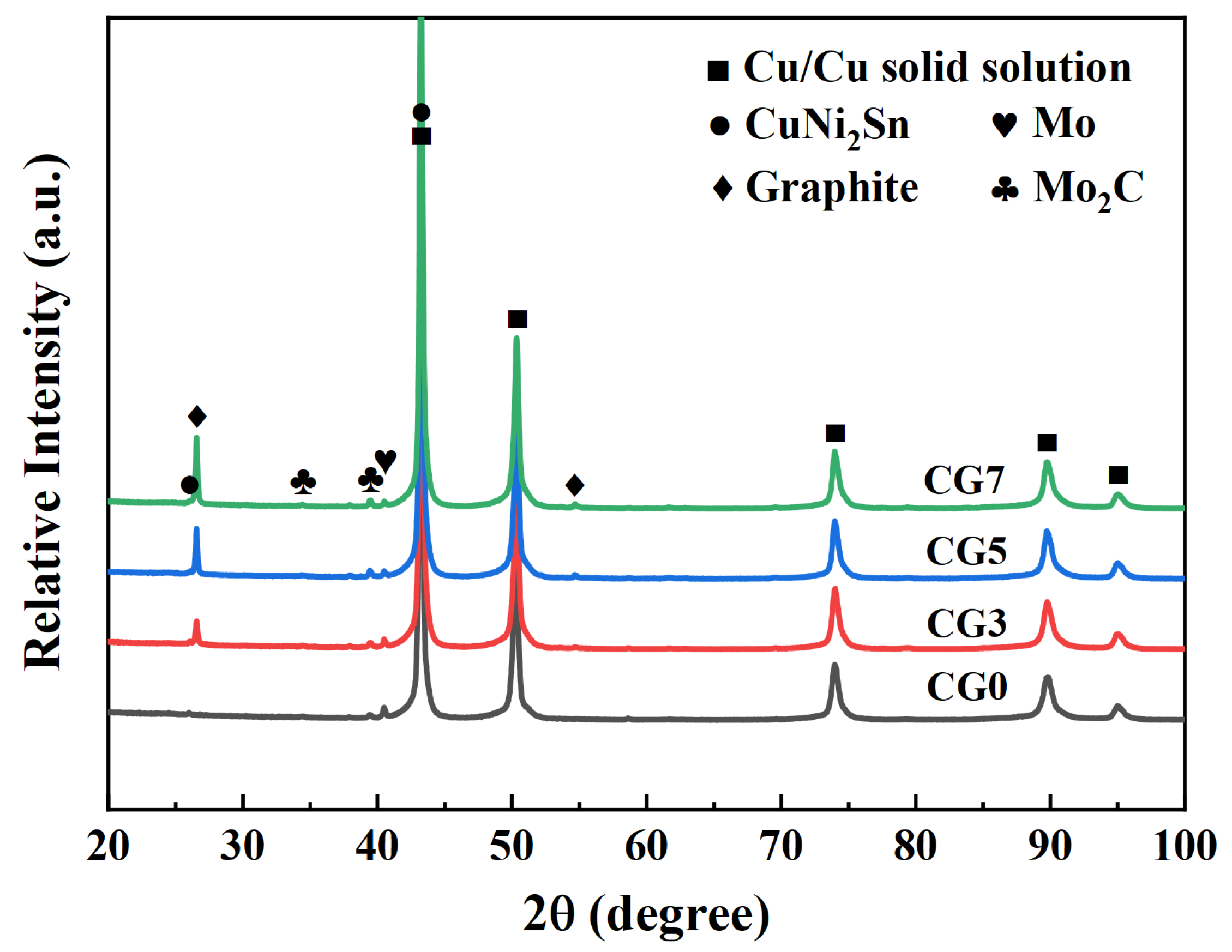
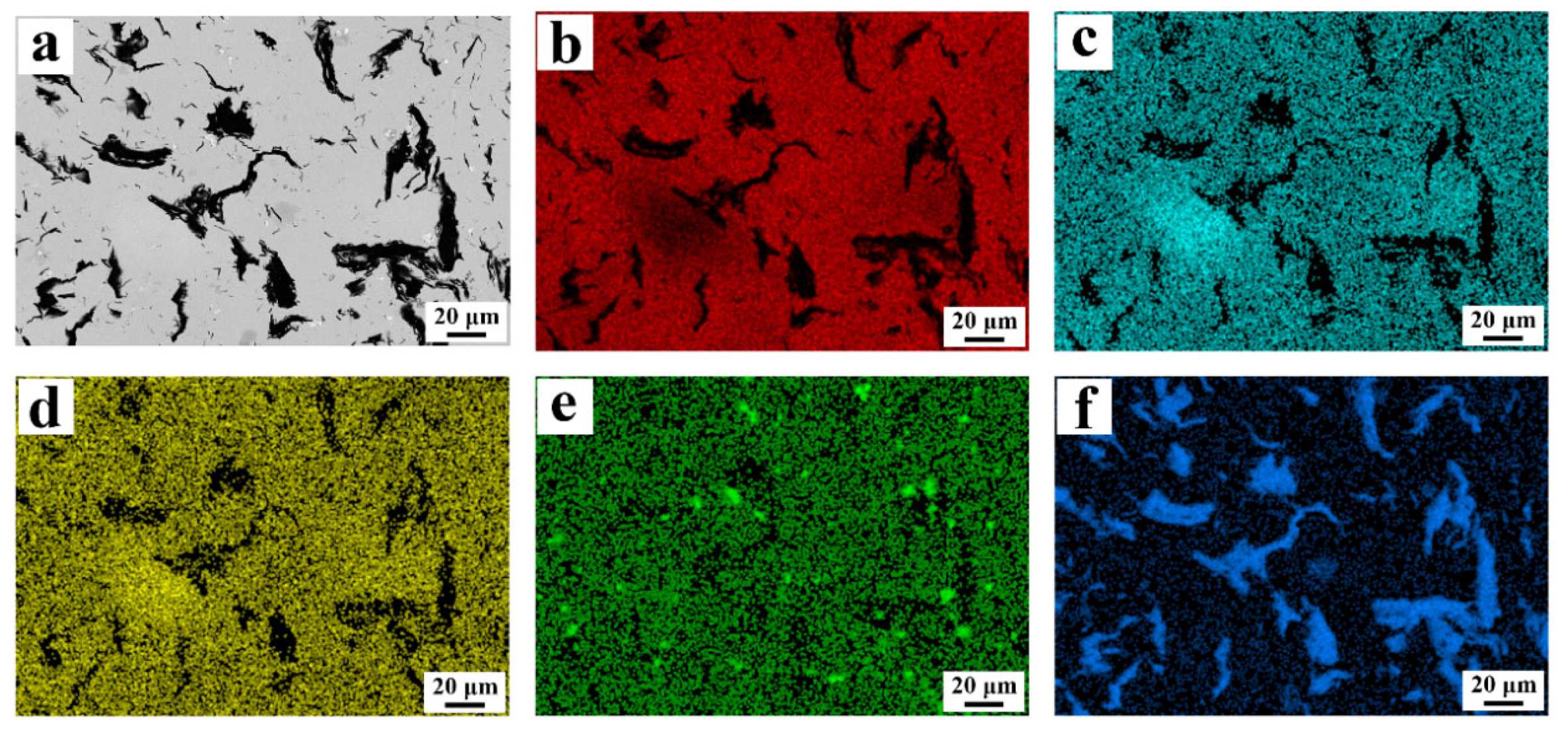
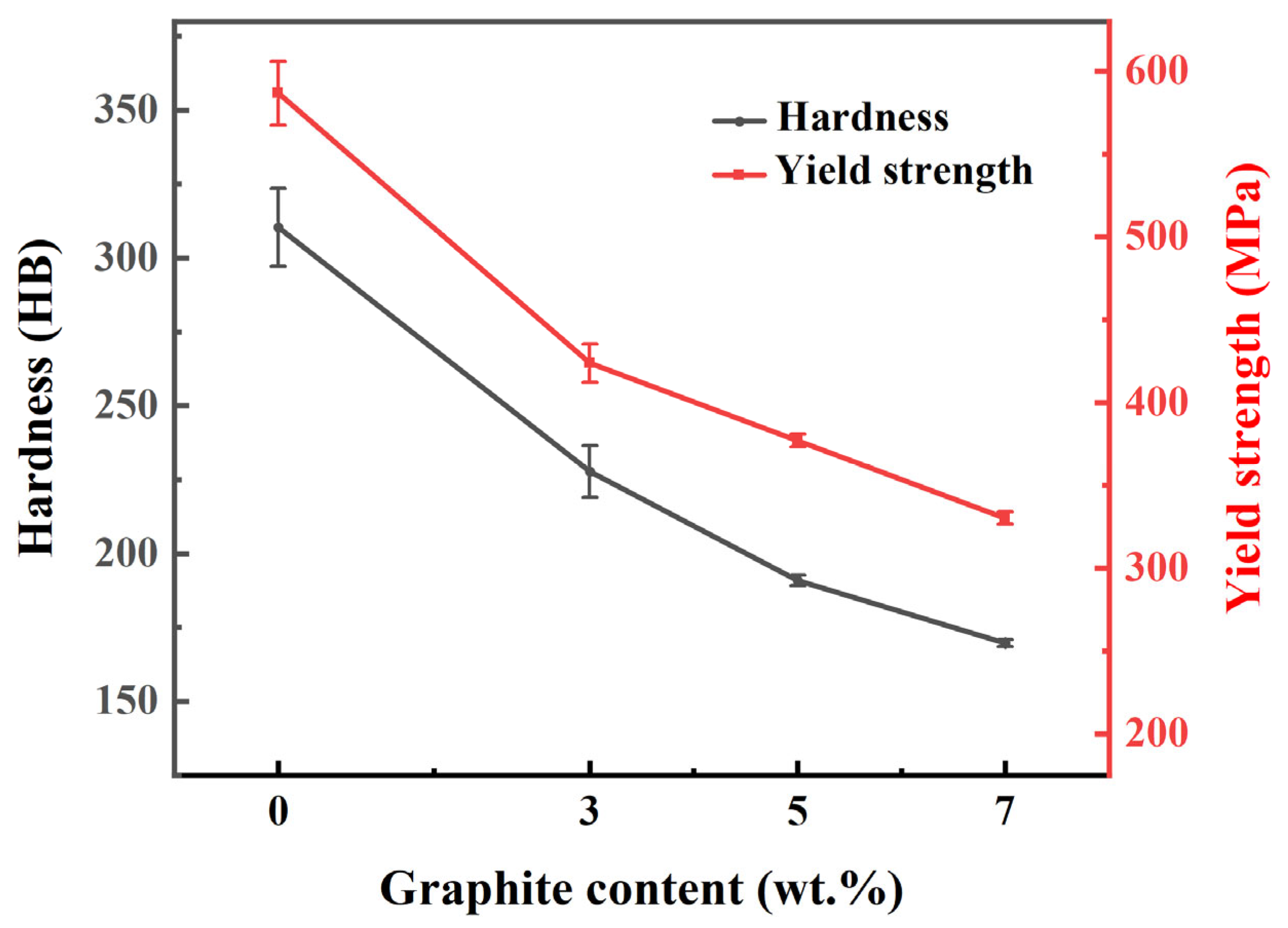
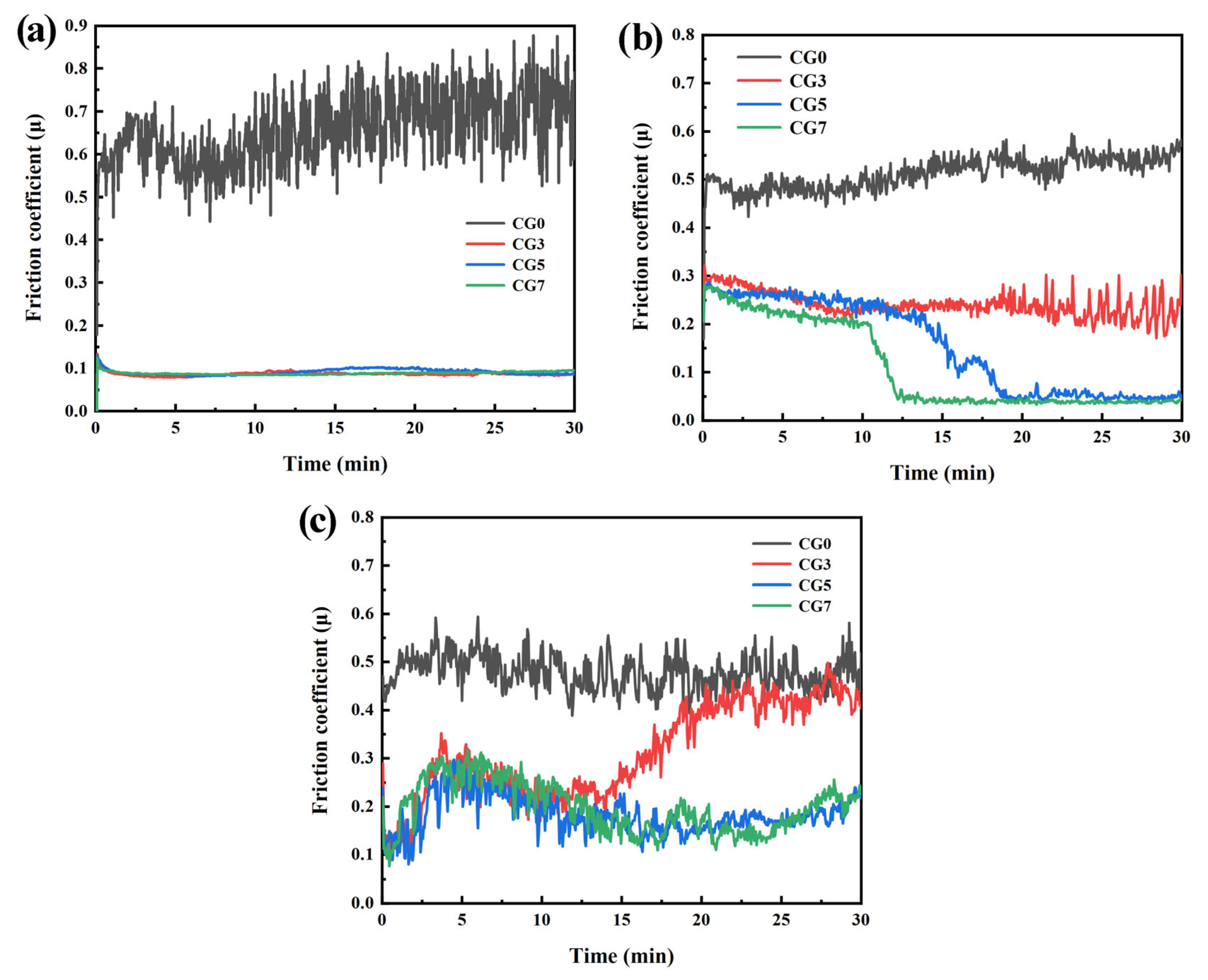
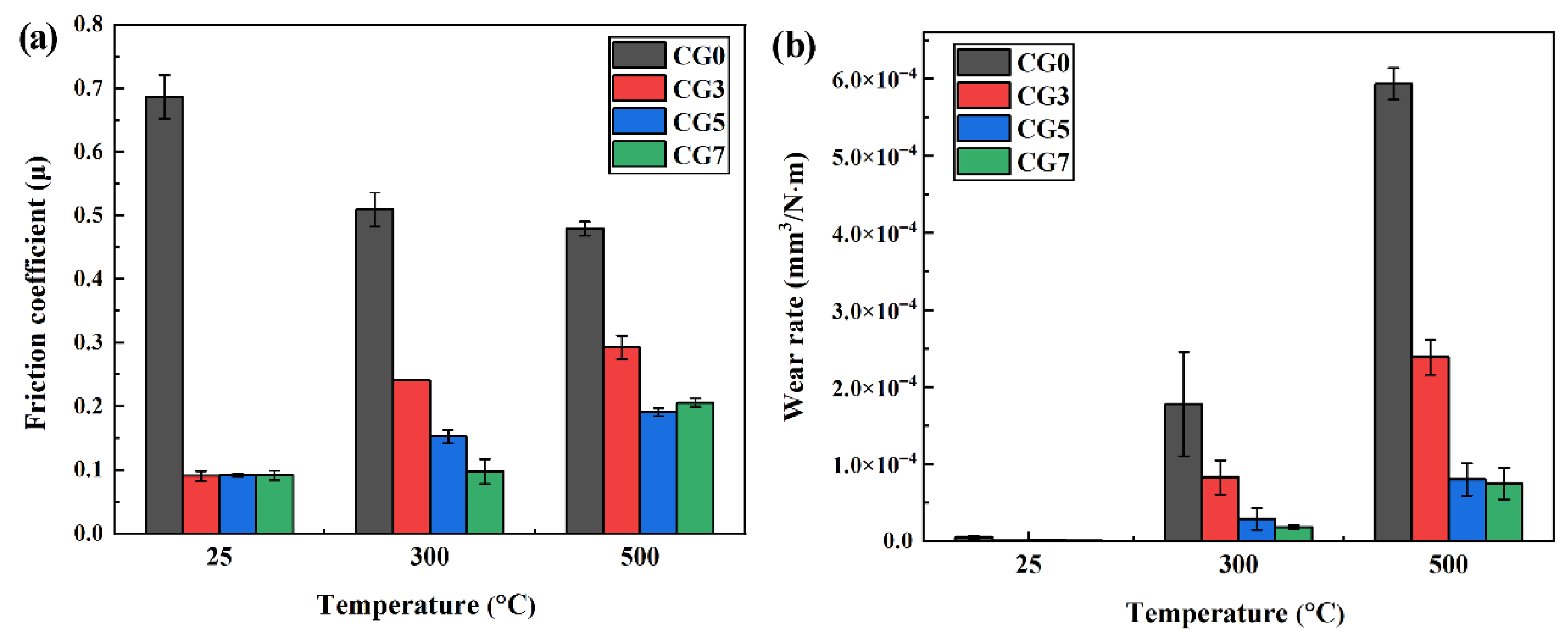
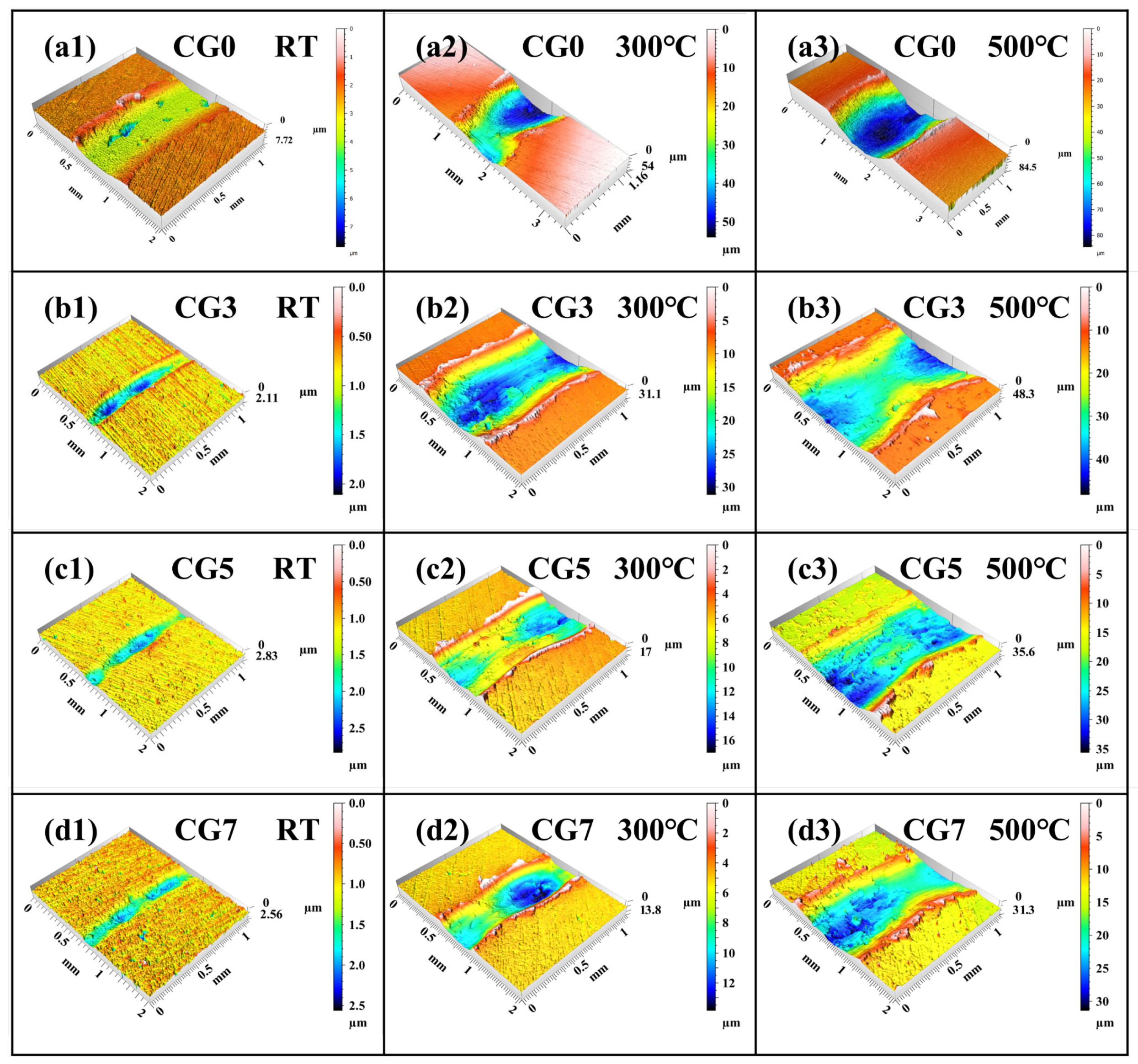
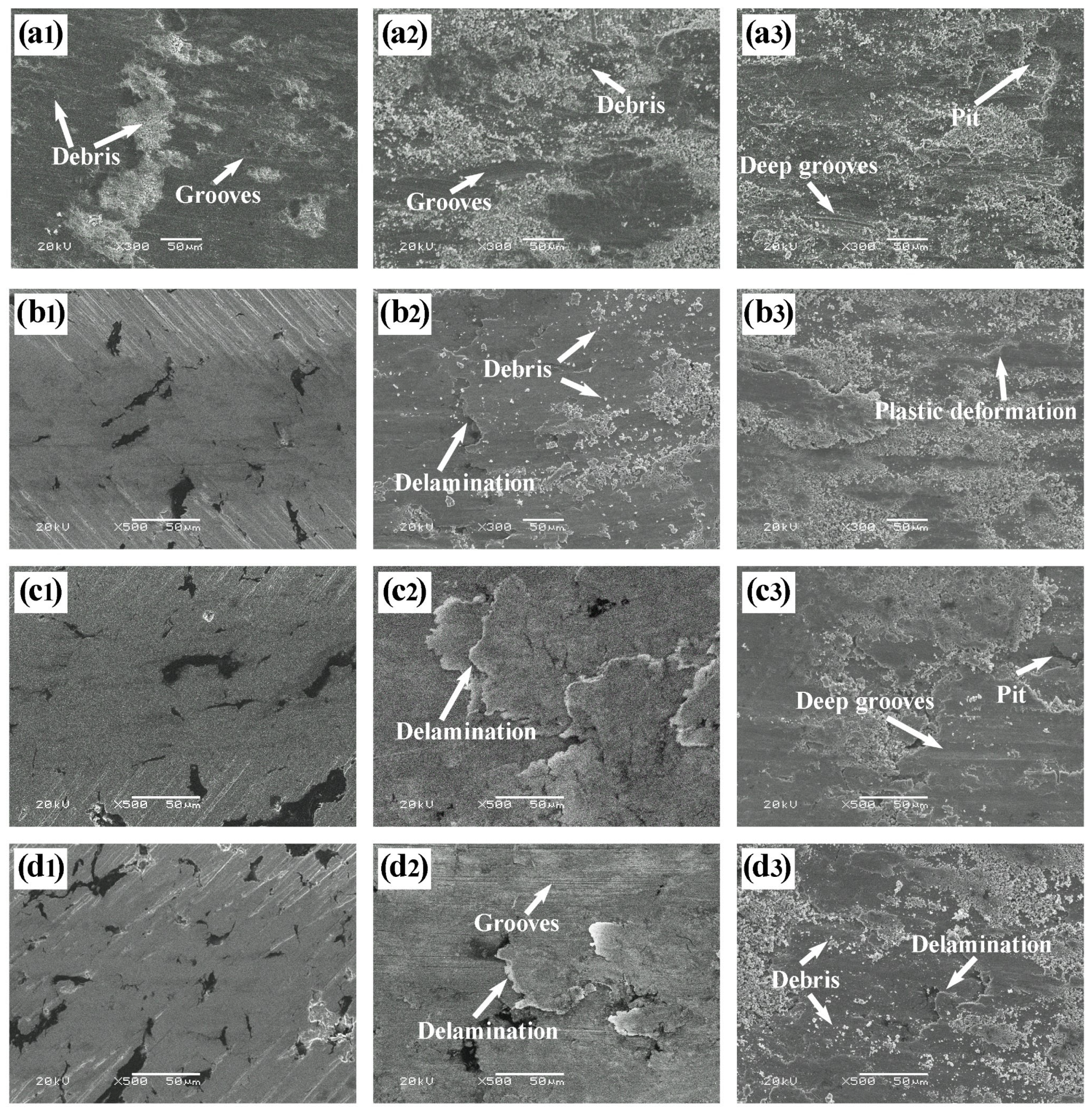
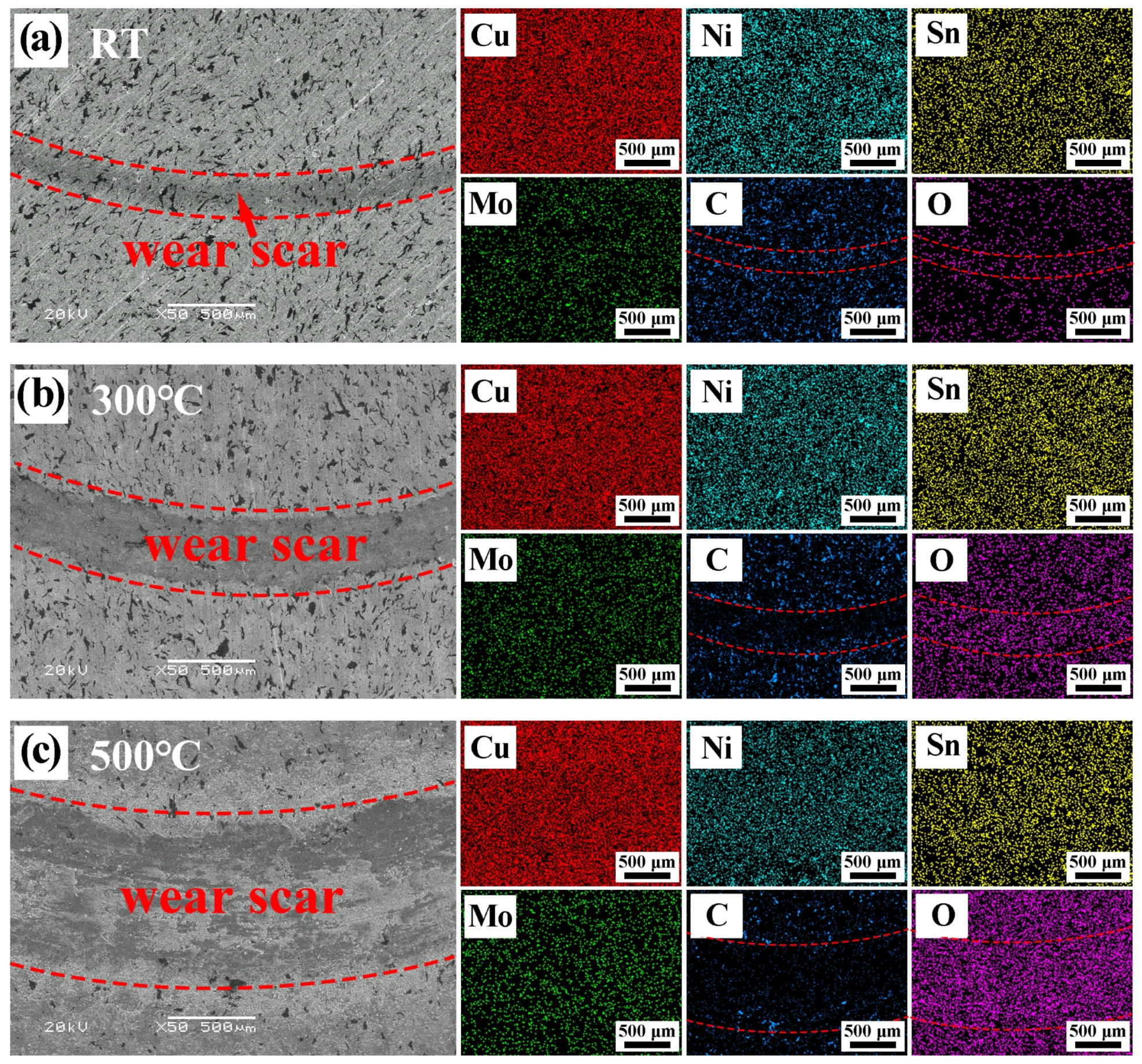
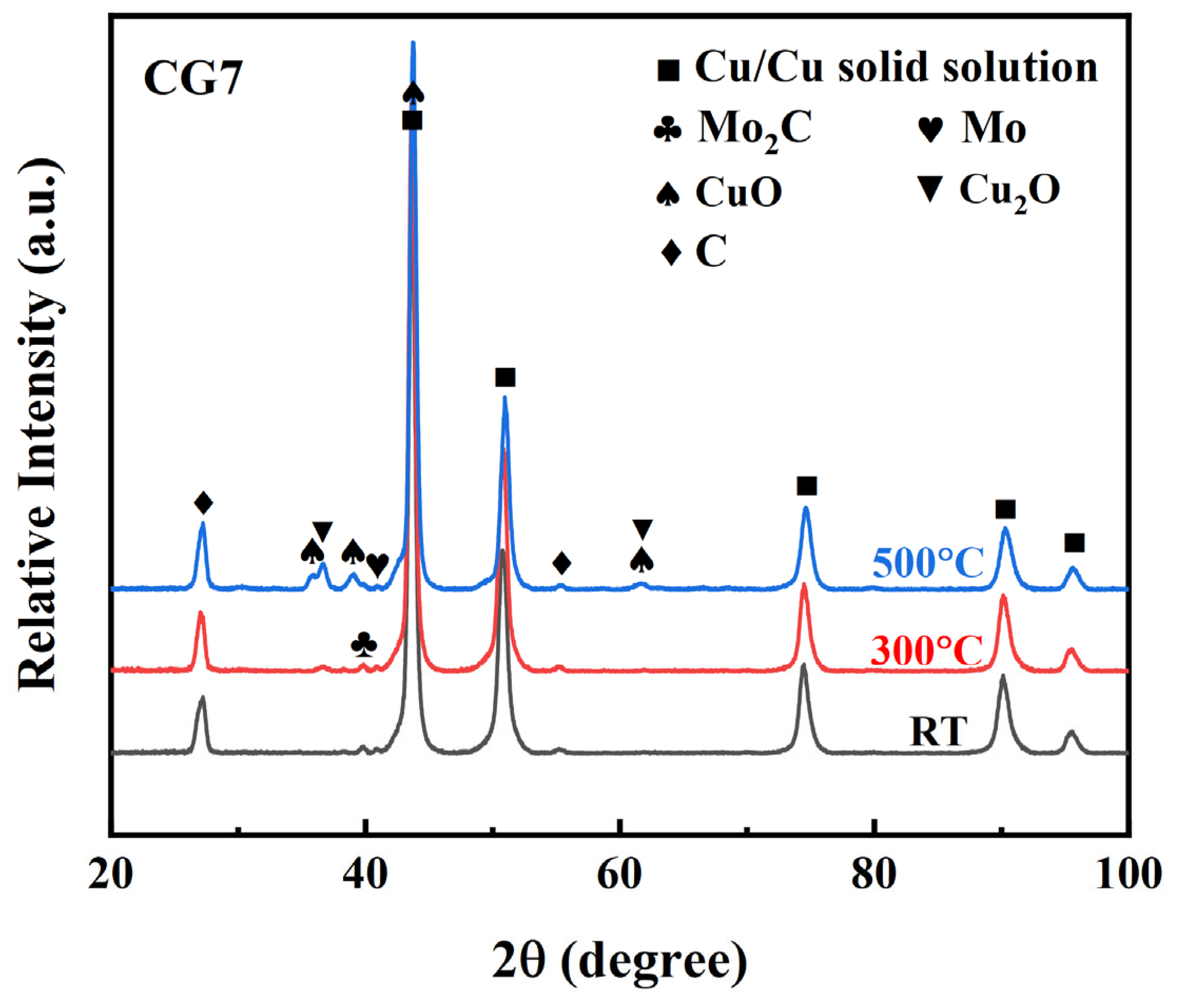
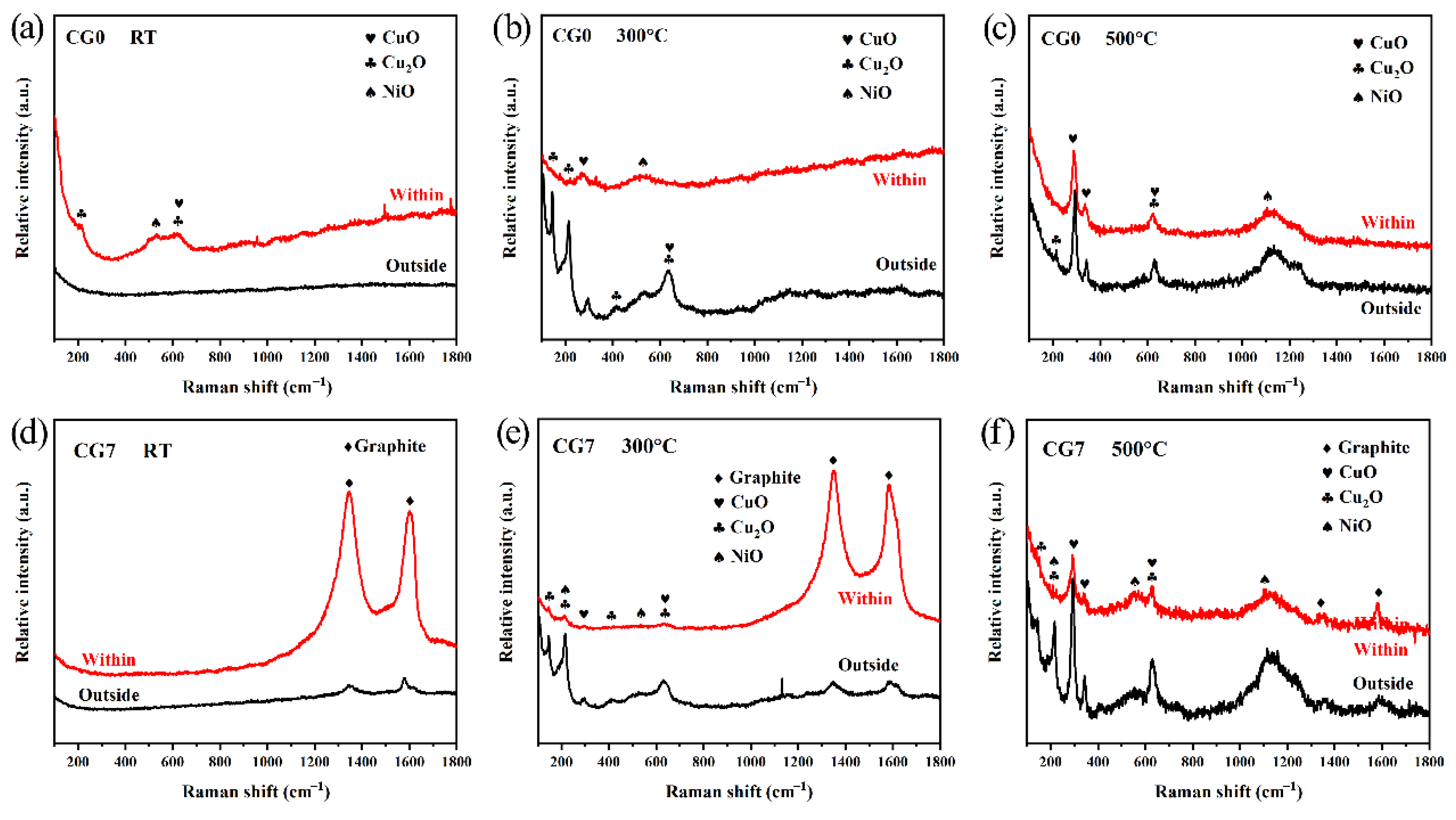
| Sample | Nominal Composition (wt.%) | Theoretical Density (g/cm3) | Actual Density (g/cm3) | Relative Density (100%) | |
|---|---|---|---|---|---|
| Alloy Matrix | Graphite | ||||
| CG0 | 100 | 0 | 8.86 | 8.95 | 101.02 |
| CG3 | 97 | 3 | 8.12 | 8.19 | 100.86 |
| CG5 | 95 | 5 | 7.70 | 7.76 | 100.78 |
| CG7 | 93 | 7 | 7.31 | 7.36 | 100.68 |
Disclaimer/Publisher’s Note: The statements, opinions and data contained in all publications are solely those of the individual author(s) and contributor(s) and not of MDPI and/or the editor(s). MDPI and/or the editor(s) disclaim responsibility for any injury to people or property resulting from any ideas, methods, instructions or products referred to in the content. |
© 2025 by the authors. Licensee MDPI, Basel, Switzerland. This article is an open access article distributed under the terms and conditions of the Creative Commons Attribution (CC BY) license (https://creativecommons.org/licenses/by/4.0/).
Share and Cite
Li, Z.; Liu, J.; Lu, S.; Liu, F.; Yang, G.; Wang, J. Effect of Graphite Content on Mechanical Properties and High-Temperature Tribological Behavior of Cu-Ni-Sn-Mo-Gr Self-Lubricating Composites. Lubricants 2025, 13, 428. https://doi.org/10.3390/lubricants13100428
Li Z, Liu J, Lu S, Liu F, Yang G, Wang J. Effect of Graphite Content on Mechanical Properties and High-Temperature Tribological Behavior of Cu-Ni-Sn-Mo-Gr Self-Lubricating Composites. Lubricants. 2025; 13(10):428. https://doi.org/10.3390/lubricants13100428
Chicago/Turabian StyleLi, Zhen, Jingde Liu, Songlin Lu, Fuyan Liu, Guirong Yang, and Jingbo Wang. 2025. "Effect of Graphite Content on Mechanical Properties and High-Temperature Tribological Behavior of Cu-Ni-Sn-Mo-Gr Self-Lubricating Composites" Lubricants 13, no. 10: 428. https://doi.org/10.3390/lubricants13100428
APA StyleLi, Z., Liu, J., Lu, S., Liu, F., Yang, G., & Wang, J. (2025). Effect of Graphite Content on Mechanical Properties and High-Temperature Tribological Behavior of Cu-Ni-Sn-Mo-Gr Self-Lubricating Composites. Lubricants, 13(10), 428. https://doi.org/10.3390/lubricants13100428





